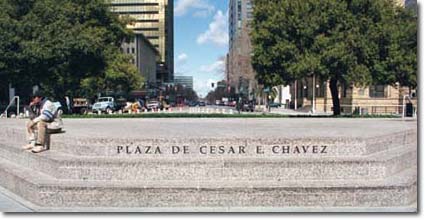
| Plaza Park Menu |
|
North end of The Plaza looking down Market Street. Alviso and the vast Cargill salt evaporation ponds lie just over the horizen. A San Jose History Walk plaque reads: "The Plaza de Cesar E. Chavez continued to serve the functions of the original Hispanic plaza - parade ground, cock-pit, race-track - but a peculiarly American use for it was as a site for public hangings. The park declined in favor during the the 1870's when San Jose's large Chinese population established itself along the eastern side of Market Street. City leaders contemplated closing the park and running Market Street through it. Public protest quashed this scheme and, when a fire destroyed the adjacent Chinatown in 1887, the park was selected as a site for a new City Hall. Until its demolition in 1958, this elaborate brick and stone building dominated the park." "In 1993, the park was renamed in honor of Cesar E. Chavez (1927-1993) - resident of San Jose, community organizer and founder of the United Farm Workers Union. The vision of the UFW was born in San Jose." No mention is made of the 24 years the Mexican government
ruled the area - from 1822 to 1846. No mention is made of the
American Indians who prospered in the area of the plaza for literally
thousands of years. No mention is made of the use of the plaza
for "correr el gallo." Clyde Arbuckle describes this
practice, "Correr el gallo required
the skill of an expert horseman and the life of a rooster. The
rooster was buried in the ground with only its greased neck and
head above the surface. As the horseman rode by at full gallop,
he reached down and snatched off the rooster's head. It was hilarious
for the spectators, but harrowing for the victim, for if the
first rider missed, another came in right behind him." In 1990, the traffic island beyond the granite "bandstand," was designated and renovated as the future site for the reviled Fallon Statue. $395,000.00 down the drain - taking into account Mr. Fallon is locked up in an Oakland warehouse, and even if he is released on his own recognizance, it will be to some dusty park in a particularly dank and dreary corner of San Jose. Yikes. |
| Plaza Park Menu |